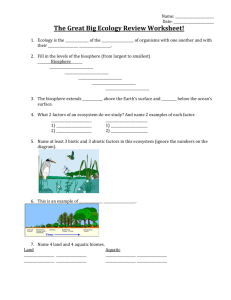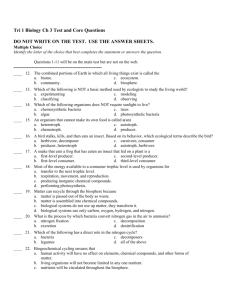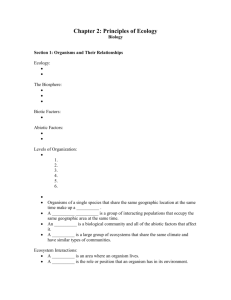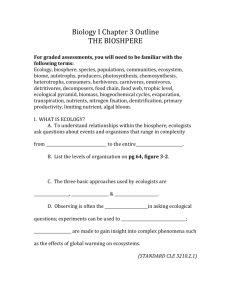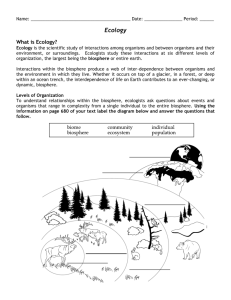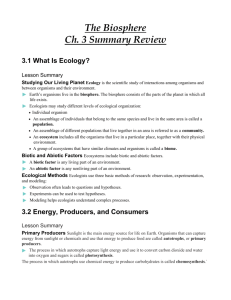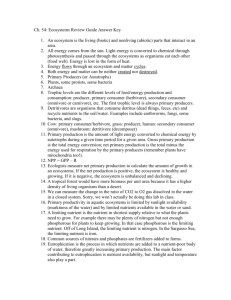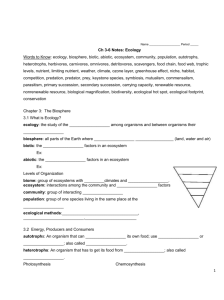CHAPTER 3 THE BIOSPHERE
advertisement
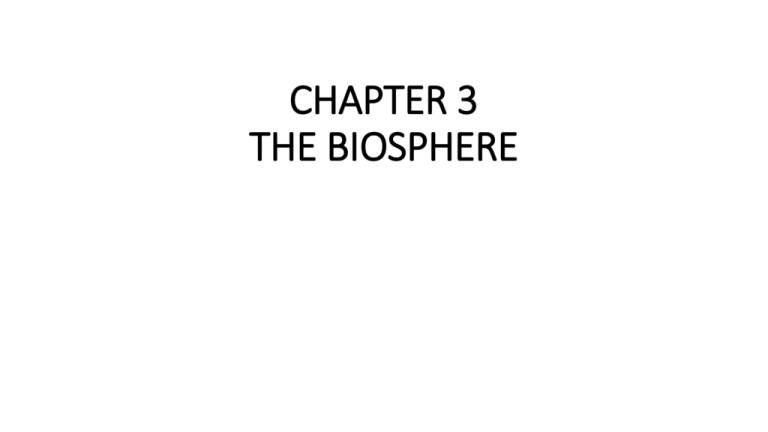
CHAPTER 3 THE BIOSPHERE 3-1 What is Ecology? Interactions and Interdependence • Ecology – the scientific study of interactions among organisms and between organisms and their environment, or surroundings. • Biosphere – The largest environment. It contains the combined portions of the planet in which all of life exists, including land, water, and air. • The biosphere goes from about 8 km above Earth’s surface to as far as 11 km below the surface of the ocean. • The interdependence of life on Earth contributes to an ever-changing biosphere. Levels of Organization • To understand relationships within the biosphere, ecologists ask questions about events and organisms that range in complexity from a single individual to the entire biosphere. • The study of ecology ranges from the study of an individual organism to populations, communities, ecosystems, biomes and to the entire biosphere. • Species – a group of organisms so similar to one another that they can breed and produce fertile offspring • Populations – groups of individuals that belong to the same species and live in the same area • Communities – groups of different populations that live together in a defined area • Ecosystem – collection of all the organisms that live in a particular place, together with their nonliving physical environment • Biome – a group of ecosystems that have the same climate and similar dominant communities. • The biosphere is the highest level of organization that ecologists study. Ecological Methods • Regardless of the tools they use, scientists conduct modern ecological research using three basic approaches: observing, experimenting, and modeling. All of these approaches rely on the application of scientific methods to guide ecological inquiry. 3-2 Energy Flow Producers • Sunlight is the main energy source for life on Earth. • Some types of organisms rely on the energy stored in inorganic chemical compounds. For example, mineral water that flows underground or boils out of hot springs and undersea vents is loaded with chemical energy. • Autotroph (producer) – an organism that can capture energy from sunlight or chemicals and use it to produce its own food from inorganic compounds (plants, some algae, certain bacteria) Energy from the Sun • Photosynthesis – when autotrophs use light energy to power chemical reactions that convert carbon dioxide and water into oxygen and energy-rich carbohydrates such as sugars and starches. • Photosynthesis adds oxygen to and removes carbon dioxide from Earth’s atmosphere. • Chemosynthesis – process by which some organisms use chemical energy to produce carbohydrates • Plants who do not get light can use chemosynthesis Consumers • Heterotroph (consumer) – organisms that rely on other organisms for their energy and food supply Many different types of heterotrophs: • Herbivores – eat only plants (cows, caterpillars, deer) • Carnivores – eat animals (snakes, dogs, owls) • Omnivores – eat both plants and animals (humans, bears, crows) • Detritivores – feed on plant and animal remains and other dead matter (mites, earthworms, snails, crabs) • Decomposers – break down organic matter (bacteria, fungi) Feeding Relationships • Energy flows through an ecosystem in one direction, from the sun or inorganic compounds to autotrophs (producers) and then to various heterotrophs (consumers) • Food Chain – series of steps in an ecosystem in which organisms transfer energy by eating and being eaten • Food chains show the one-way flow of energy in an ecosystem • Food Webs – network of complex interactions formed by the feeding relationships among the various organisms in an ecosystem • More complex than a food chain. A food web links all the food chains in an ecosystem together. Each step in a food chain is called a trophic level. Producers make up the first trophic level. Consumers make up the second, third, or higher trophic levels. Each consumer depends on the trophic level below it for energy. Ecological Pyramids • Ecological pyramid – a diagram that shows the relative amounts of energy or matter contained within each trophic level in a food chin or food web. There are three different types of ecological pyramids: energy pyramids, biomass pyramids, and pyramids of numbers Energy pyramid – • Only about 10% of the energy available within one trophic level is transferred to organisms at the next trophic level Biomass pyramid • Biomass – the total amount of living tissue within a given trophic level. Usually expressed in terms of grams of organic matter per unit area. • A biomass pyramid represents the amount of potential food available for each trophic level in an ecosystem. Pyramid of numbers – • Based on the numbers of individual organisms at each trophic level. 3-3 Cycles of Matter Recycling in the Biosphere • Unlike the one-way flow of energy, matter is recycled within and between ecosystems. • Biogeochemical cycles – process in which elements, chemical compounds, and other forms of matter are passed from one organism to another and from one part of the biosphere to another • Matter can cycle through the biosphere because biological systems do not use up matter, they transform it. The Water Cycle • All living things need water to survive. Water moves between the ocean, atmosphere, and land • Evaporation – the process by which water changes from liquid form to an atmospheric gas • Transpiration – the process by which water enters the atmosphere by evaporating from the leaves of plants Nutrient Cycles • Nutrients – all the chemical substances that an organism requires to live • Every living organism needs nutrients to grow and carryout essential life functions. Like water, nutrients are passed between organisms and the environment through biogeochemical cycles. Three nutrient cycles play important roles in the biosphere: the carbon cycle, the nitrogen cycle, and the phosphorus cycle The Carbon Cycle • Carbon is the key ingredient in all living organisms. It is also found in the oceans, in the air, and in certain types of rocks. There are four different kinds of processes involved in the carbon cycle: • Biological processes, such as photosynthesis, respiration, and decomposition of plants and animals • Geochemical processes, such as the release of carbon dioxide gas to the atmosphere by volcanoes • Mixed biogeochemical processes, such as the burial of carbon-rich remains or organisms and their conversion into coal and petroleum by the pressure of the overlying earth • Human activity, including mining, burning fossil fuels, and cutting and burning forests The Nitrogen Cycle • All organisms need nitrogen to make amino acids, which are used to build proteins • Some bacterial convert nitrogen gas into ammonia, known as nitrogen fixation. • Nitrogen fixation – process of converting nitrogen gas into ammonia • When organisms die, decomposers return nitrogen to the soil as ammonia. The ammonia may be taken up again by producers. Other soil bacteria convert nitrates into nitrogen gas in a process called denitrification. • Denitrification – conversion of nitrates into nitrogen gas The Phosphorus Cycle • Phosphorus is essential to living organisms because it forms part of important life-sustaining molecules such as DNA and RNA. • Phosphorus does not enter the atmosphere. It remains mostly on land in rock and soil minerals and in ocean sediments. Nutrient Limitation • Primary Productivity – the rate at which organic matter is created by producers. • The amount of available nutrients affects primary productivity. • Limiting nutrient – when an ecosystem is limited by a single nutrient that is scarce or cycles very slowly Farmers apply fertilizers to their crops to boost their productivity. Fertilizers contain three important nutrients: nitrogen, phosphorus, and potassium. These nutrients help plants grow larger and more quickly than they would in unfertilized soil. When an aquatic ecosystem (ex – oceans) receives a large input of a limiting nutrient (ex – runoff from heavily fertilized fields) the result is often an immediate increase in the amount of algae and other producers. This is called algal bloom.
